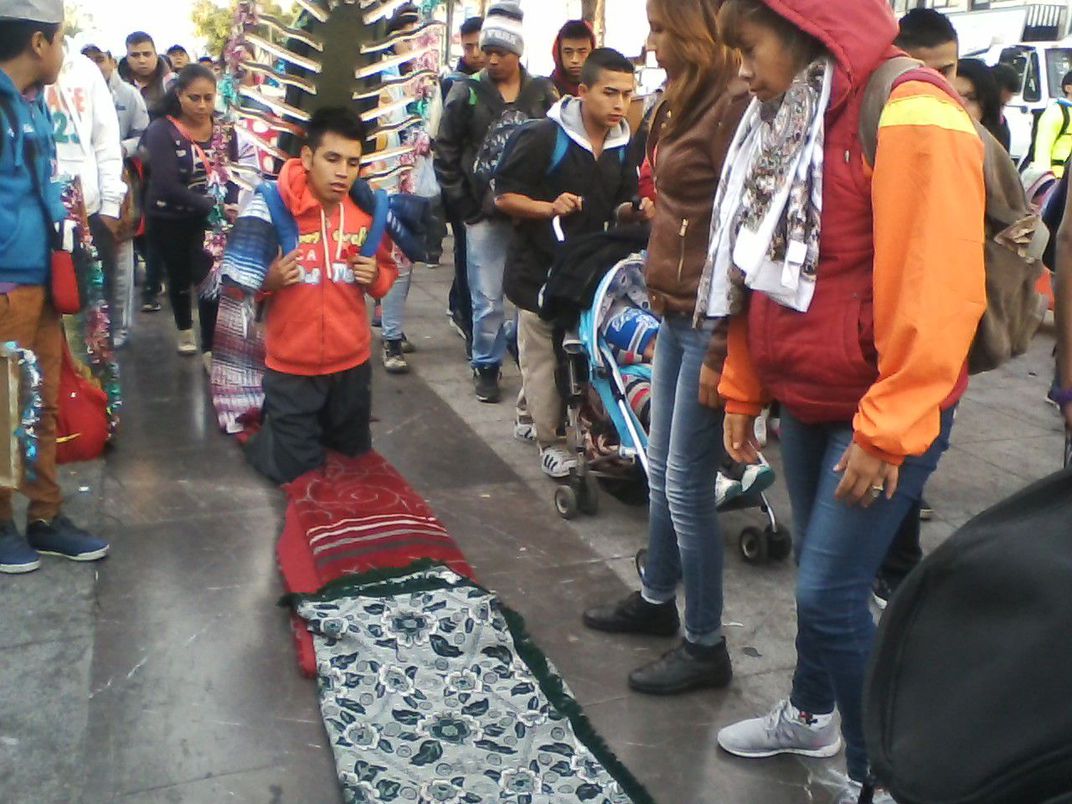In December 1531, on Tepeyac Hill, on the northern edge of what is now Mexico City, a woman who identified herself as the Virgin Mary appeared four times before Juan Diego, an indigenous convert to Roman Catholicism. Speaking in Nahuatl—Juan’s native language—she asked that a shrine be erected on the hill in her honor. According to the legend, Juan reported the incident to the local religious authorities, but they did not believe him. Suddenly, a life-size image of the Virgin appeared on Juan’s cloak.
Not long afterwards, a shrine was built, followed by a chapel, a church and now the Basilica of Our Lady of Guadalupe, where high above a moving walkway that keeps anyone from lingering too long, Juan Diego’s cloak is displayed behind bullet-proof glass.
Each year, an estimated 20 million people visit the Basilica—including another 7 million who visit annually on December 12, the day when the image of the Virgin is said to have miraculously appeared on Juan’s cloak.
On December 12, 2016, observing as a folklorist, I was among the 7 million, making the trek to the Basilica despite the online warnings to stay away. “It is not the best day to visit. . . . The place is always crowded but today is simply too much,” cautioned one destination expert for Mexico City. I was eager to experience the most important pilgrimage site in the western hemisphere—eclipsed perhaps only by Mecca, Vatican City, Golden Temple and the Ganges River (though visitor counts at these sites are often imprecise).
So at 7 a.m. I found it odd to be riding a nearly deserted public bus from downtown Mexico City to the northern suburb of Tepeyac. Once there, I realized that most everyone else had arrived the day before and had been celebrating much of the night. Exhausted pilgrims—some in sleeping bags and some inside tents, but most with only a thin blanket under or over them—were spread across the enormous expanse of the cement plaza outside the Basilica.
Others had been sleeping in the hundreds of buses that were parked in the narrow streets around the Basilica. Kitchens began serving breakfast. Cleaners began sweeping and collecting debris. Gradually everyone started making their way towards the Basilica, some advancing slowly on their knees with blankets spread before them, some carrying on their backs—or sometimes across their chests—a large framed painting of the Virgin, thereby replicating the image that had appeared on Juan Diego’s cloak in 1531.



As the day got warmer, and outer jackets were removed, I began noticing the hundreds of different colorful T-shirts that the pilgrims were wearing. Some T-shirts simply stated the name of the group or where they were coming from. Some identified the number of years that this particular group had been making the annual pilgrimage. Others identified their mode of transportation, such as Peregrinación Ciclista, meaning that they had made the pilgrimage by bicycle.
But what most of the T-shirts had in common was the image of the Virgin that appeared on Juan Diego’s cloak: the Virgin modestly looking down, her hands folded together in prayer, wearing a star-decorated mantle, from which rays of light emanate to form a full-body halo.
I detest the overuse of the word iconic. It is so often poorly applied in contemporary discourse. But here I want to use it as it was meant to be. The Virgin of Guadalupe’s image is the absolute essence of iconic.
Perhaps the most important reason why the Virgin of Guadalupe is so revered in Mexico is that she appeared before Juan Diego, an indigenous commoner, just ten years after Spanish conquistadors had captured the Aztec capital of Tenochtitlan (present-day Mexico City). By favoring a representative of those who have been marginalized or oppressed in Mexico, the Virgin became a liberating symbol of freedom and social justice.
According to John Moran Gonzalez, director of the Center for Mexican American Studies at the University of Texas at Austin, “Our Lady is seen as the champion of the underdog, of the Indian, of all those who lack power in society. . . .In that sense she continues to be relevant as long as disparities in economic and political power exist. “
Throughout Mexico, you will see her universally recognized image not only in home altars—as a liturgical object of reverence and devotion—but also in the form of calendars, cups, murals, tattoos, even window treatments. And at the Basilica on December 12, her image appears on T-shirts everywhere.






The origins of the T-shirt are obscure. The name is an obvious reference to the shape of the shirt, which forms the letter T when spread out flat, which at one time were all just plain white.
The “graphic T-shirt,” with words or pictures, became popular in the 1960s and 1970s, along with that era’s cultural expressions of youthful rebellion. Yet to be confirmed is the fascinating theory that dates the first appearance of the graphic T-shirt to the 1939 film The Wizard of Oz. Emerald City inhabitants were spotted wearing green tees with bold OZ lettering.
No matter its origins, the once-humble T-shirt is now perhaps more important for expressing opinions than for expressing fashion. The American Civil Liberties Union even offers advice on “Speaking Out with Your T-Shirt.”
In Tepeyac on December 12, the T-shirt takes on a new and powerful significance. The T-shirts adorned with the Virgin’s image and when worn in unison, meet all the requirements of folk costume, as scholars define the term. It promotes solidarity among members of the group who wear it. It provides continuity from year to year, especially when noting the addition of another year that the practitioner makes the pilgrimage. And perhaps most importantly it helps maintain the origins of the pilgrimage itself by replicating the image of the Virgin—an image that yes, we must call iconic.





